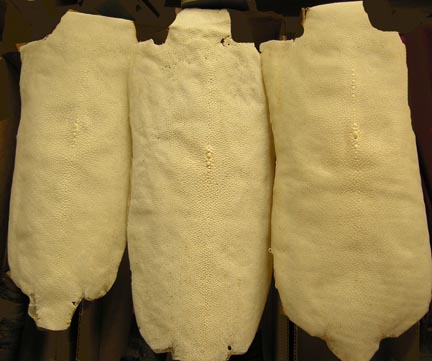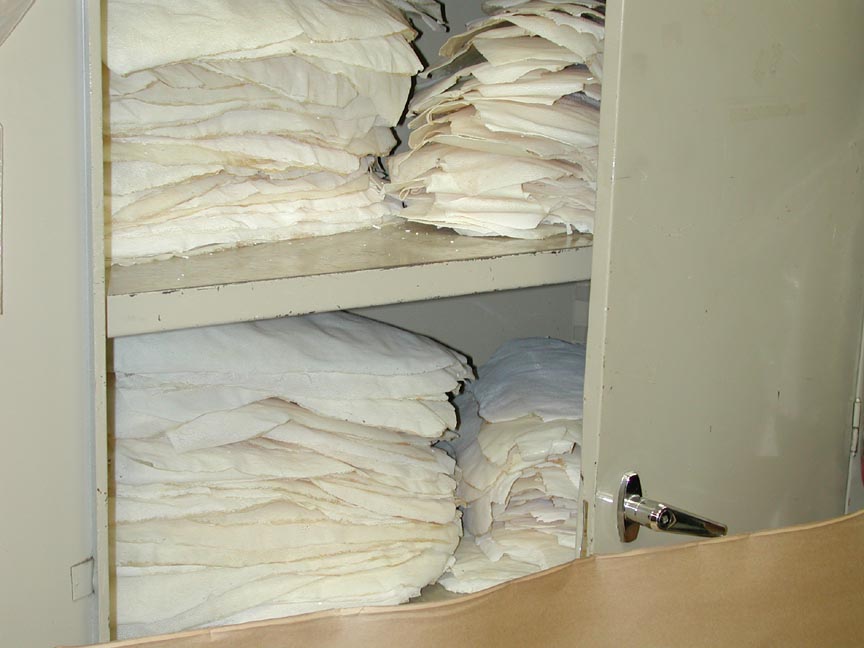
|
| Stingray Skin - aka: Samé, Samégawa and "the pebbly white stuff under the wrap", Shark, etc. The skin of the common Stingray has been used on Japanese Sword handles for centuries, mostly due to its rough texture which, when wrapped with cord, prevents the cord from slipping. In spite of the fact that the entire skin is 100% equal 'inch by inch' in its ability to restrict movement of the cord, it is the arrangement and size of of the nodes (white bumps) that determines the value of the skin. |

|
| Fred Lohman Company is the premier importer and supplier of Samegawa (Stingray skin) to the Tsuka (sword handle) restoration industry. Only high-grade, reasonably-priced skins are used in our new handles as well as handle restoration when warranted. (We recommend replacement if the existing skin shows signs of wear such as age warping, cracks, separations or missing pieces. |
| In its natural state, the skin is
dirty, smelly and dries into a misshapen mess. Making it presentable for commercial use is a labor-intensive process: the outer side of the skin
is scrubbed with heavy duty wire brushes to remove the yuk &
guck. Scrapers, wire brushes and large rasps (files) are used to scrape away all of the
remaining flesh from the bottom of the skin, a laborious process which ultimately results in a skin which is thin and relatively smooth to the touch. The scraped & cleaned skins are soaked
in containers of high strength Peroxide Bleach to until the skin becomes
almost snow white in color. At this point, it is technically classified as
'rawhide'. Those of us who have been involved as dealers purchasing skins in large quantities from Asian suppliers fully understand and appreciate the time and effort involved in the cleaning process. As a word of caution, there are a few web site 'suppliers' who will send photo's of their skins, make promises and take your money,,, the problem is that they don't deliver the skins. ( frigging thieves ! ) And their local cops do nothing. Ask me before sending money to anyone who you may be unsure of. |
| Stingray skin is available and custom sizes can be made available to fit your individual needs. The skin pieces (natural rawhide, 4 inches wide) is priced per running inch. If you are already aware of how to get the skin to conform to the shape of the handle, Great ! (if not, ask! ). The next step (if you want black-colored skin) is for you to apply black lacquer to the skin. Use a quality spray lacquer such as Tamiya Synthetic Lacquer, or even enamel applied with an artist brush. That's how it's done, not a mystery... Simple and easy! Note that chemically tanned skins available on the market for craft use have had the rough nodes ground off, creating a smooth skin that is unsuitable for Japanese sword handles. The Japanese used the natural rough Stingray skin under the cord to prevent sliding and loosening. Additionally, the skin is directional in that it is rougher when 'petted' (rubbed) in one direction and less so the other direction. Therefore, care should be taken to insure that the skin is oriented properly so that it is rougher when rubbed in the direction toward the end of the handle. When 'full wrapped' around the handle, as opposed to strips or side panels, it makes the Tsuka (Handle) considerably stronger and less apt to fail during stressful situations. |